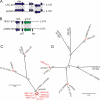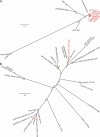Complete nucleotide sequence analysis of plasmids in strains of Staphylococcus aureus clone USA300 reveals a high level of identity among isolates with closely related core genome sequences
- PMID: 20943864
- PMCID: PMC3008496
- DOI: 10.1128/JCM.01050-10
Complete nucleotide sequence analysis of plasmids in strains of Staphylococcus aureus clone USA300 reveals a high level of identity among isolates with closely related core genome sequences
Abstract
A community-associated methicillin-resistant Staphylococcus aureus (CA-MRSA) strain known as pulsed-field type USA300 (USA300) is epidemic in the United States. Previous comparative whole-genome sequencing studies demonstrated that there has been recent clonal emergence of a subset of USA300 isolates, which comprise the epidemic clone. Although the core genomes of these isolates are closely related, the level of diversity among USA300 plasmids was not resolved. Inasmuch as these plasmids might contribute to significant gene diversity among otherwise closely related USA300 isolates, we performed de novo sequencing of endogenous plasmids from 10 previously characterized USA300 clinical isolates obtained from different geographic locations in the United States. All isolates tested contained small (2- to 3-kb) and/or large (27- to 30-kb) plasmids. The large plasmids encoded heavy metal and/or antimicrobial resistance elements, including those that confer resistance to cadmium, bacitracin, macrolides, penicillin, kanamycin, and streptothricin, although all isolates were sensitive to minocycline, doxycycline, trimethoprim-sulfamethoxazole, vancomycin, teicoplanin, and linezolid. One of the USA300 isolates contained an archaic plasmid that encoded staphylococcal enterotoxins R, J, and P. Notably, the large plasmids (27 to 28 kb) from 8 USA300 isolates--those that comprise the epidemic USA300 clone--were virtually identical (99% identity) and similar to a large plasmid from strain USA300_TCH1516 (a previously sequenced USA300 strain from Houston, TX). These plasmids are largely divergent from the 37-kb plasmid of FPR3757, the first sequenced USA300 strain. The high level of plasmid sequence identity among the majority of closely related USA300 isolates is consistent with the recent clonal emergence hypothesis for USA300.
Figures



Similar articles
-
Transmission and microevolution of USA300 MRSA in U.S. households: evidence from whole-genome sequencing.mBio. 2015 Mar 10;6(2):e00054. doi: 10.1128/mBio.00054-15. mBio. 2015. PMID: 25759497 Free PMC article.
-
Demography and Intercontinental Spread of the USA300 Community-Acquired Methicillin-Resistant Staphylococcus aureus Lineage.mBio. 2016 Feb 16;7(1):e02183-15. doi: 10.1128/mBio.02183-15. mBio. 2016. PMID: 26884428 Free PMC article.
-
USA300 methicillin-resistant Staphylococcus aureus in Stockholm, Sweden, from 2008 to 2016.PLoS One. 2018 Nov 7;13(11):e0205761. doi: 10.1371/journal.pone.0205761. eCollection 2018. PLoS One. 2018. PMID: 30403684 Free PMC article.
-
Subtle genetic changes enhance virulence of methicillin resistant and sensitive Staphylococcus aureus.BMC Microbiol. 2007 Nov 6;7:99. doi: 10.1186/1471-2180-7-99. BMC Microbiol. 2007. PMID: 17986343 Free PMC article.
-
Comparative Genomics of Community-Associated Methicillin-Resistant Staphylococcus aureus Shows the Emergence of Clone ST8-USA300 in Geneva, Switzerland.J Infect Dis. 2016 May 1;213(9):1370-9. doi: 10.1093/infdis/jiv489. Epub 2015 Oct 13. J Infect Dis. 2016. PMID: 26464204
Cited by
-
Role of Staphylococcus aureus Formate Metabolism during Prosthetic Joint Infection.Infect Immun. 2022 Nov 17;90(11):e0042822. doi: 10.1128/iai.00428-22. Epub 2022 Oct 26. Infect Immun. 2022. PMID: 36286525 Free PMC article.
-
Major families of multiresistant plasmids from geographically and epidemiologically diverse staphylococci.G3 (Bethesda). 2011 Dec;1(7):581-91. doi: 10.1534/g3.111.000760. Epub 2011 Dec 1. G3 (Bethesda). 2011. PMID: 22384369 Free PMC article.
-
Contribution of the Staphylococcus aureus Atl AM and GL murein hydrolase activities in cell division, autolysis, and biofilm formation.PLoS One. 2012;7(7):e42244. doi: 10.1371/journal.pone.0042244. Epub 2012 Jul 31. PLoS One. 2012. PMID: 22860095 Free PMC article.
-
Plasmid profiles among some ESKAPE pathogens in a tertiary care centre in south India.Indian J Med Res. 2019 Feb;149(2):222-231. doi: 10.4103/ijmr.IJMR_2098_17. Indian J Med Res. 2019. PMID: 31219087 Free PMC article.
-
Anticancer metallohelices: nanomolar potency and high selectivity.Chem Sci. 2016 Feb 1;7(2):951-958. doi: 10.1039/c5sc03677a. Epub 2015 Oct 26. Chem Sci. 2016. PMID: 28808525 Free PMC article.
References
-
- Baba, T., F. Takeuchi, M. Kuroda, H. Yuzawa, K. Aoki, A. Oguchi, Y. Nagai, N. Iwama, K. Asano, T. Naimi, H. Kuroda, L. Cui, K. Yamamoto, and K. Hiramatsu. 2002. Genome and virulence determinants of high virulence community-acquired MRSA. Lancet 359:1819-1827. - PubMed
-
- Clinical and Laboratory Standards Institute. 2008. Performance standards for antimicrobial susceptibility testing; 18th informational supplement. Clinical and Laboratory Standards Institute, Wayne, PA.
Publication types
MeSH terms
Substances
Associated data
- Actions
- Actions
- Actions
- Actions
- Actions
- Actions
- Actions
- Actions
- Actions
- Actions
- Actions
- Actions
- Actions
- Actions
- Actions
- Actions
- Actions
- Actions
- Actions
Grants and funding
LinkOut - more resources
Full Text Sources
Medical

